Harmonic balancer, crank pulley, and an ounce of unobtanium
Harmonic Balancer
Motor was dyno tested to 7k RPM with a Fluidampr harmonic balancer. Fluidampr has a pretty good reputation, but the unit used on my motor was mostly just what they had lying around in the shop, vs. an ideal. From the looks of it, it had done a few rotations. Including, perhaps, a few on the shop floor-
After a typically lengthy amount of research, ended up with a solution, an ATI Super Damper.
Now, it’s not like there’s one ATI Super Damper for a small-block Chevy. A search on Summit for a ’67 Camaro returns 34 unique part numbers. Why so many?
There are several choices you have for fitment. Starting with the hub, the piece that slides onto the end of the crank – you can go with steel or aluminum.
Steel is a bit heavier, but a lot easier to make work. Because the damper relies on a tight fit to the crank, and the different coefficients of thermal expansion, the aluminum hubs essentially have to be custom-bored to fit most cranks. They also require more frequent inspection and replacement, and I’d come across at least a couple online stories of catastrophic failure. Ugg. Not something I’d be looking forward to. And while it would be lighter than the steel, most of that weight is at a very small radius from the crank centerline, so the impact on MOI (moment of inertia, the object’s resistance to being spun), would be the smallest of these parts.
Part 1 – Hub: Steel or aluminum (steel)
Next is the piece pictured above, the damper element itself. Internally these are comprised of two or three damper rings, separated by a tuned and serviceable elastomer. The three ring dampers are more costly and a bit more heavy, but offer superior damping characteristics. I chose three because the weight difference was negligible, and this was hedging somewhat the next choice made…
Part 2 – Rings: 2 or 3 (3)
The dampers are offered in varying diameters, essentially 5″, 6″ or 7″. The stock Z28 damper, which was a popular unit on all racing Chevy motors for a long time, is actually a big heavy 8″ piece. Again, as with ring choice, the greater the radius of the damping elements, the more they can do to handle those crank harmonics. I made a compromise choice with 6″. If the car was only ever autocrossed I might do 5″, but I do plan to do the occasional track day too, where it will spend a bit more time at high RPM. The 7″ unit would have been OK too but they don’t seem to be stocked anywhere, and I wouldn’t want to wait to have one made.
Part 3 – Diameter: 5″, 6″, 7″ (6″)
Lastly, the metal used out between the elastomers, can be steel or aluminum. The steel options are significantly heavier than aluminum (8lbs. vs. 3lbs. typical), and reportedly don’t offer much in the way of improved damping characteristics – mostly just less cost. Went with aluminum here.
Part 4 – Damper material: Steel or aluminum (aluminum)
The above 2x2x3x2 only equates to 24 options – there are others for supercharged motors, weird offset items, things like that. A truly staggering array!
Now, some may recall a book by David Vizard, where he mentions testing a bunch of different dampers, and the heaviest one made the most HP. So why didn’t I get the heaviest one? My thinking here is the ATI should do a very good job for its weight, and this unit is at least 5 pounds lighter than the heavier option – so even if the car is down a HP or two, that’s 5 fewer pounds the front tires will have to try to drag around every autocross corner. Everything is a compromise…
###
Crank Pulley
In a previous post I showed the weight savings from a billet aluminum alternator pulley, over a stock cad-plated piece – it was significant. I’m hoping the weight savings from a similar billet aluminum crank pulley are similar. This crank pulley is from the same “performance ratio” (somewhat underdrive) March kit. They are very nice looking pieces, with a shiny anodize that’s easy to clean-
Not sure exactly how underdriven this pulley set is. A plus side of the underdriving, in addition to “freeing up” some HP, is it tends to help keep the water and power steering pumps from cavitating at high RPM. Even though the 302 motors could spin fast, the ancillaries weren’t always built to handle it well.
Since the fan is driven off the water pump pulley, the fan will turn more slowly, which frees up HP (mechanical fan can sap 40HP at high rpm!) but has the downside, of maybe not turning the fan as quickly at idle. That could mean higher temps – not usually a big deal in autocross – but it could also mean problems for the battery, if the charging system isn’t able to keep up. Actually have my pimpy battery for the car, that’ll be another post, once I decide where it’s going…
Above is a shot at the March power steering pulley in place. Apparently the stock PS pulley is a big heavy cast iron piece, yikes! This pulley should do a lot to mitigate the 20+ lbs. a power steering system adds to the car. The pump itself isn’t that heavy, nor are the lines or brackets. I bet half the weight is in the heavier steering box, and at least that piece is behind the front wheels. Can you tell yet I’m obsessed with weight distribution? 🙂
Here’s the crank pulley mated to the new damper and hub, as it will be in the car:
###
Unobtainium
So what holds those things together? A few fasteners. One is the main crank pulley bolt, threaded into the crank itself, operating at a very small radius.
Additionally, there are three threaded fasteners, 3/8″-16 x 1.25″. Pretty small and light units, but they’re connected right to the crank, operating at a couple inch radius, contributing a good bit to the engine’s MOI. Given that we’re free to replace the crank pulley, means we’re also free to choose what fasteners to use in holding in the replacement.
We’ve all heard stories of people with big $ going through their cars, chopping down every heavy steel bolt to minimum length, and replacing every other bolt/nut they can with something much lighter, to great effect. I was curious how much benefit there would be on these units, as being small, they wouldn’t be too expensive, and since they rotate at crankshaft speed out ahead of the front wheels, would be just about the best weight to replace…
The three steel bolts shipped with the ATI damper don’t feel heavy for their size, and weigh in at 2.3oz for the trio-
Now on to the unobtainium (using that word in the Lockheed Martin SR-71 Skunkworks sense) bolts. Equivalent in size to the ATI supplied bolts, they are…
…1.05oz lighter! Over 45% reduction in weight, not too bad. If one were to go through the whole car and replace every fastener with one of this material, in a just-long-enough length, bet you could save over 50% of existing fastener weight. On a car like this that’d be not insignificant – possibly 20 pounds.
Still, I won’t be running out to replace a whole bunch more fasteners, though with all the allowances in the class, there are quite a few which could be. Just wanted a little unobtainium in the car to give it a bit more of that cachet, and to see for myself what sort of real savings it could bring.
When you guys see how heavy my exhaust system is, those three little bolts will seem really silly. 🙂
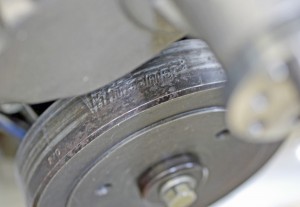
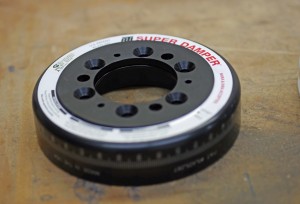
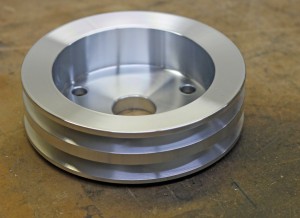
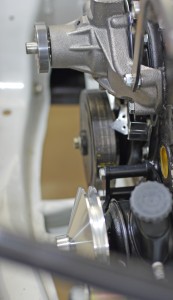
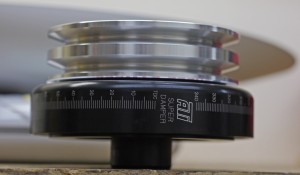
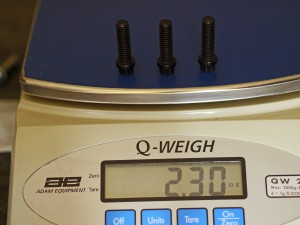
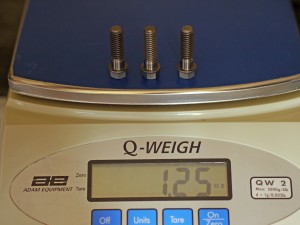
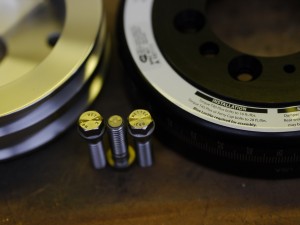
Leave a Reply
You must be logged in to post a comment.